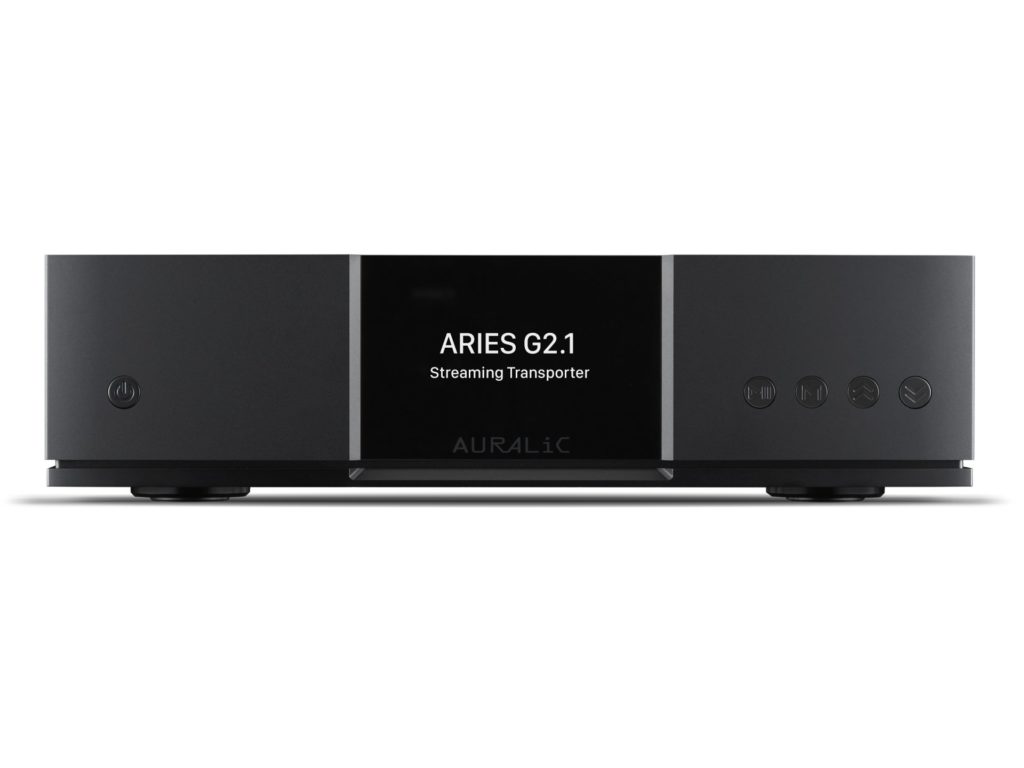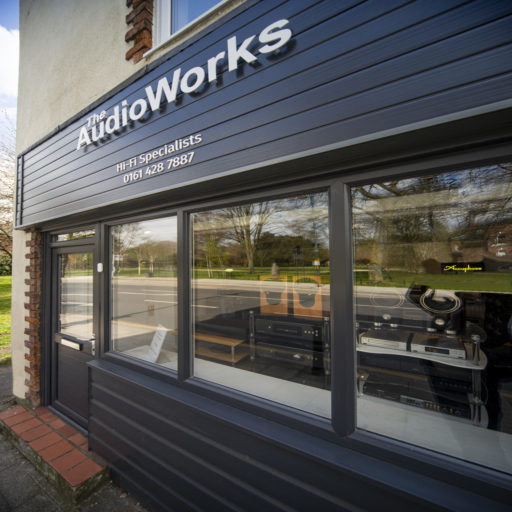
Absolutely top performing streamer – plug it into a good DAC, take care of your network environment and you have amazing performance. Hi Fi+ Magazine quite likes it too!!
HIFI+193 Auralic_LR.pdf
EQUIPMENT REVIEW
AURALiC ARIES G2.1 network streamer
by Jason KennedyIt’s rare to see any form of dissent from manufacturers, but some are kicking back, and AURALiC has published a pretty firm stance on MQA. Devised under the auspices of Meridian founder
Bob Stuart MQA is a compression system to enable streaming of high-resolution files at a time when internet bandwidth available in the home was inadequate to the task. However, in the six-plus years since its introduction internet speeds have significantly increased and streaming services such as Qobuz can deliver lossless files at up to 24/192 without requiring any extra processing. MQA persuaded Tidal its files were the way forward and Tidal offers its highest resolution streams only in this format. To support MQA requires MQA-licensed technology at every stage of the processing journey, and this causes AURALiC consternation. AURALiC’s prior MQA passthrough option in their streaming devices allowed those with appropriately equipped DACs to unfold MQA files. Now they have developed “playback technology that simulates the sonic character of MQA’s digital filter”. AURALiC not only sees MQA as a form of DRM (digital rights management) but also call it out for being lossy: “Since MQA’s compression method permanently removes bits from the original file, it must do so in a lossy manner, compromising the integrity of the full file, and does not deliver an actual high-resolution music format.” I suspect that the company will gain respect from this stance, and those who remain unconvinced by MQA’s benefits are right behind them.
The ARIES G2.1 is AURALiC’s latest and most ambitious streamer. It is effectively a
network bridge because it only has digital in and outputs, you need a separate DAC to produce an analogue signal. Connection to music servers on the network can be wireless or via ethernet cable, ditto for streaming services on the WAN (wide area network, e.g. the rest of the planet). The output is via USB (galvanically isolated), Toslink optical, coax, AES or Lightning Link. The latter is AURALiC’s proprietary connection and uses HDMI socketry. It allows on/off switching from one unit as well as passing a digital stream. As the ARIES is one of only two G2.1 components to feature a front panel power switch, this is more useful than it might seem. The deal with the .1 is not as small as that suffix would suggest, it indicates that the chassis is a Unity II type that consists of two cases in the one box. The one you see is fabricated from machined aluminium while the internal compartment is copper which is highly prized for its shielding capabilities. The feet are also more sophisticated than on the previous G2 models. These have multiple springs inside to provide a degree of insulation from vibration in the supporting furniture. Even ostensibly solid-state devices like a streamer are sensitive to vibration.
Under the copper lurks a Tesla G2 platform which offers high processing speeds and twice as much memory and storage as the earlier models, in this case, a gigabyte of memory cache. On top of this, you can add a 2.5inch drive (HDD or SSD) to the ARIES and use it as a music server and given that there are 4TB SSDs available in this size, this could be a lot more cost-effective than an audiophile quality server. Another cool feature is that with an appropriate USB disc drive, you can use the HDD input on the ARIES to playback CDs, controlling the process with the Lightning DS app (iOS only). AURALiC lists a few suitable drives, including Melco’s fancy D100 and other more affordable options. The drive’s output is treated to the same processing power as network sources so the quality should be in approximately the same ballpark.
The ARIES is Roon ready, but AURALiC has its control software that tends to deliver higher sound quality in my experience. Lightning DS is not as comprehensively informative or rock-solid as Roon, but it does an outstanding job for a free app and looks great. The latest update (6.6) allows the user to switch in some of the previously only available facilities in the menu structure, including parametric EQ, resampling, and speaker placement compensation. These are pretty powerful tools for tailoring a sound that works for your ears, and being able to switch them in with ease is a clear bonus. Speaker placement allows you to dial in the distance to each speaker from the listening position and fine-tune each channel’s gain. It uses some form of delay and balance control to aid set up where physical placement is compromised. The only things that I would like to see added to Lightning DS is a playlist that shows tracks already played and those coming up. When you go down a rabbit hole with Qobuz, for instance, it’s not always easy (nearly impossible) to remember what you’ve been playing. The other minor niggle is that when viewing the list of artists in your collection those that have artwork missing from any album get no image on the artist icon, even if the other 20 albums under that artist do have it. Missing metadata is the bane of the streaming audio enthusiast’s life.
In the first instance, I used the ARIES G2.1 with its natural partner the VEGA G2.1 recently reviewed for this publication (issue 191), it was still in the system. The source was an Innuos Zenith SE server and the network switch an Ansuz X-TC, a combination that hit the ground running with the first random piece of music I played, ostensibly for warm-up purposes.
I warmed up (figurative and literally… it’s bloody cold as I write this) with Arve Henriksen’s Cartography [ECM] which is a pretty good recording for sure but through this AURALiC pairing revealed itself to be somewhat better than expected. It has a presence and realism that’s uncanny thanks to the impressively low-level resolution and dynamic range that the ARIES and VEGA revealed. The next album I put on sounded veiled and manipulated, by comparison, ECM knows its stuff that’s for sure, but you need quiet and resolute equipment to make that as clear as was apparent here.
I found a great recording of Ryan Adams and the Cardinals live on archive.org a few years back (Live at Das Haus) and it always sounds surprisingly real, here it was genuinely impressive with bass notes to die for in the intro to ‘Magnolia Mountain’. Bootlegs never sounded like this in the analogue era! While the ARIES loves a great recording, it can do remarkable things for lesser ones. Bugge Wesseltoft and Prins Thomas’ ‘Furuberget’ [Jazzland] reveals itself to be that rare thing; a track sounds better on digital than vinyl. The AURALiC pairing brings out a sparkle in the highs which opened up the soundstage even though this is an artificial, reverb derived effect. The acoustic on the Engegård Quartet’s Haydn pieces [String Quartet, In D, Op. 76, No. 5 – Finale, 2L] is natural, the timbre of the original instruments
“This made an excellent case for the G2.1, which delivered significantly greater realism of tone.”
resonating in the space while the playing sounds more ‘math chamber’ than Bach. On an older recording, Quartetto Italiano playing Beethoven [Complete String Quartets, Decca], the piece’s enormous dynamic range is superb, the sense of wooden- bodied instruments vibrating in front of you being strong indeed. Charles Mingus’ Pithecanthropus Erectus [Atlantic] was less successful, but because it sounds so good on the vinyl, analogue recordings tend to be like that as a rule. A less ancient alternative in D’Angelo’s ‘Untitled (How Does It Feel)’ [Voodoo, Virgin] was far more successful and surprisingly open. It generally sounds thick, and plenty of this effect remained, but the ARIES made it easier to hear into the mix.
I contrasted the CAD USB I cable I generally use with the HDMI that AURALiC includes in the box, which is not a fancy cable and probably cost less than the box. Unsurprisingly this did not improve upon the £650 CAD cable which delivers far greater image depth, tighter timing and much stronger engagement. AURALiC tells me that you need to look at an Audioquest Diamond HDMI for best results, which is more pricey still. I also briefly contrasted the ARIES G1
with its bigger and newer brother; this made an excellent case for the G2.1, which delivered significantly greater realism of tone, clarity of bass, articulation across the board and a sense that the sound was less loud without changing volume level. The G1 rarely sounds loud on its own, but that’s the problem with comparisons; they make it apparent that you’re missing out, ignorance being bliss and all that. I also used a different DAC to see if there was a particular synergy between the two AURALiC components. The alternative was a Merason DAC1, which is similar to the ARIES G2.1 proved to be a fabulous partner. The combo producing calm, focussed and solid sound with a depth of image and power of drive that was compelling; in fact, it proved difficult to put down so engaging were the results.
The degree of transparency offered was not entirely beneficial, the problem being that material provided by the so-called hi-res streaming services sounded notably flat compared with the music on a local drive. This system made an excellent case for owning the piece you want to hear at its best. It was still effortless to enjoy streaming services so long as the music was strong enough but the thrill power served up by Innuos, and Melco servers were in another league. Someone introduced me to the mid-’90s Joan Osborne album Relish [Mercury] recently with the track ‘Pensacola’, her raw vocal and the power of straightforward backing giving it a rare emotional impact. Scanning the rest of the titles I realised that I’d heard her before on a compilation singing ‘St. Teresa’, great to find it wasn’t a one-off. The ARIES G2.1 helped clarify the lyrics of both tunes and illuminate the tone of the electric guitar. At times like this, I wonder why we pay so much for vinyl, I know it can be better, but when streaming is this good, you wonder if it’s worth it.
I read another reviewer saying that he thought CD sounded so much better than streaming audio that he couldn’t see the point. I think the problem is that doing streaming well is as hard as building a great turntable, arm, cartridge
Reproduced from HI-FI+ Issue 193
www.hifiplus.com
EQUIPMENT REVIEW / AURALiC ARIES G2.1
“The ARIES G2.1 is an exceptional streamer with an excellent feature range and an increasingly sophisticated control app.”
TECHNICAL SPECIFICATIONS
Type: Solid-state network streamer Analogue Inputs: none
Streaming Inputs: Network shared folder(via Ethernet), USB Storage, USB CD Drive (via USB), Internal Music Storage
DAC Resolution/Supported Digital Formats: FLAC/WAV/MP3, etc. Sampling rate for D/A conversion up to 384kHz/32 bit, DSD512
Music services/Wi-Fi inputs: Qobuz, Tidal, Bluetooth, Airplay
Analogue Outputs: N/A
Digital Outputs: Lightning Link, onecoaxial S/PDIF (via RCA jack), one TOSLink, one AES/EBU, one USB (to compatible DAC)
Frequency Response: Distortion (THD + Noise): User Interface: 4.3inch display (on main
unit), Lightning DS application
software for iOS
Dimensions (H×W×D): 96 × 340 × 320mm Weight: 9.3kg
Price: £4,199Manufacturer: AURALiC URL: auralic.com
UK Distributor: AURALiC Europe Tel: +44 (0)7590 106105
URL: auralic.comand phono stage combo and we have had decades to figure that out. To make streaming sound convincing, engaging and even thrilling, you need to get all the pieces of the puzzle sorted; this includes the network switch, the music server, the streamer and the DAC. AURALiC’s work on the G2.1 series shows that if you focus on addressing the many problems that afflict this still- evolving technology, it is possible to produce results that can compete with any other format.
Having got to this point the listening continued with Patricia Barber’s take on ‘Summertime’ [A Distortion of Love, Antilles], an evergreen standard if ever there was. Her voice at the start is positively ethereal, expanding into depths way behind the speakers and forcing your eyes closed to experience the sublime. The darkness of the background and the subtle percussion work that builds so slowly giving the piece a mesmerising quality that contrasts violently with the following track, ‘Subway Station #5’. Here, the drums’ energy forces your hands to attempt to emulate its activities, and you realise it’s a good thing that listening is a solitary pursuit. The ARIES G2.1 is an exceptional streamer with an excellent feature range and an increasingly sophisticated control app
that gives instant access to those streaming services that are worth buying. If you get the components that surround it up to the same standard, you will have digital audio the likes of which few have enjoyed.
Reproduced from HI-FI+ Issue 193
www.hifiplus.com


